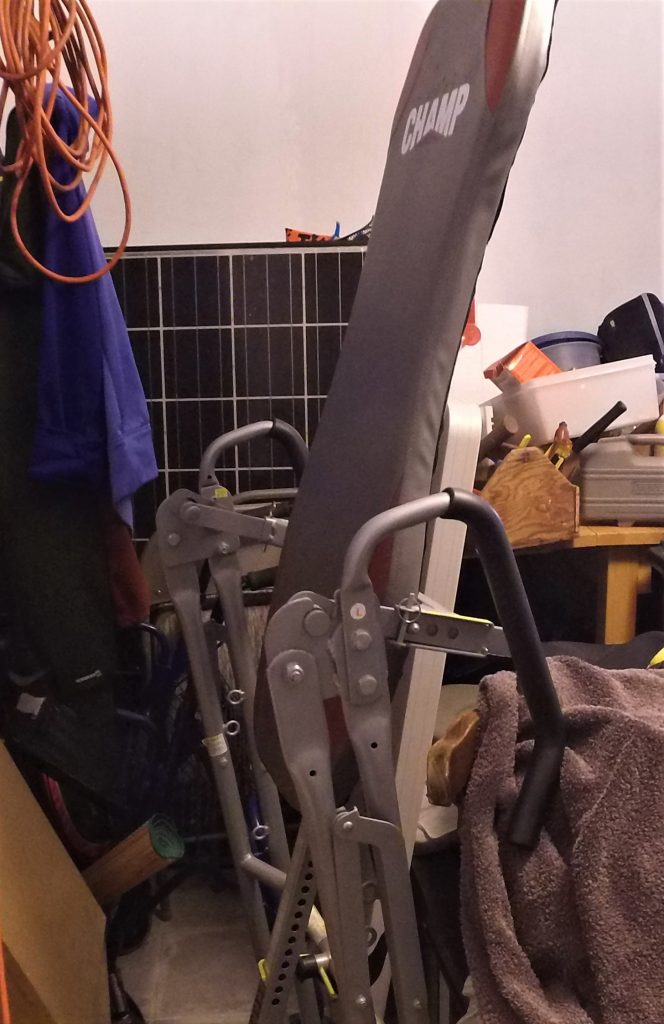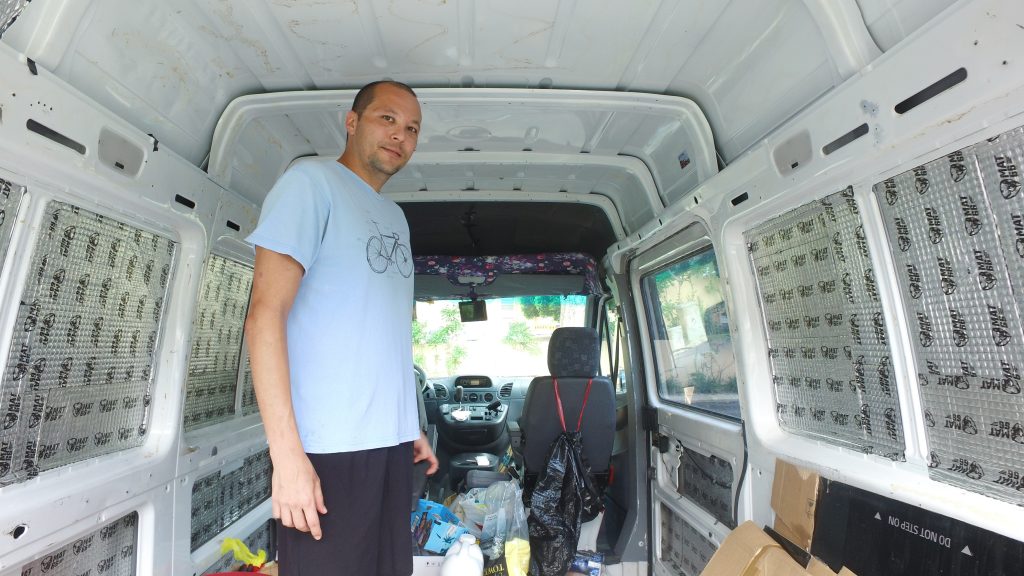Stan’s big dream meant downsizing. In October of 2019, he left Maryland for the balmy shores of Miami. Partly because he had spent the better part of his youth there, but also because it would give him the time and space to trick out a van. He looked forward to living as a part-time nomad.
Stan figured his custom-made van/RV would be the perfect vehicle to bring him and his mountain bike on weekend excursions. Mountain biking was the latest in a series of active hobbies, which began with karate as a kid (Stan earned a black belt), running (he completed the San Diego marathon in 2012), and road biking (he rode 40-50 miles per day).
But both his hobbies and his physical fitness level were sacrificed when Stan’s spine decided to sacrifice a disc.
On February 2nd, 2020, Stan went to his job as a shuttle van driver for a hotel. He had only been in the job for two weeks, and didn’t intend to stay there long-term. In Maryland, he had been a dispatcher, and he was still looking for a job that was more in line with his experience.
But in the meantime, the shuttle driver job gave him something to do, and a way to enjoy the Florida sunshine. Besides, it’s not like he minded driving a van.
It wasn’t a particularly noteworthy day. The highlight was getting shanghaied into setting up a conference room at the hotel. But when he lifted a table, he felt an immediate twinge. He knew something bad had happened, though he couldn’t say exactly what. His back was uncomfortable, sure, but it was nothing that everyday pain meds couldn’t handle.
For two days, Stan carried on as usual. The discomfort in his back didn’t go away, but it didn’t keep him from functioning, either.
That changed on the third day, when an intense, stabbing pain set in. His car ride to work only aggravated his pain, and when he arrived, he was not in the mood for more driving.
He talked to his boss, who insisted he go to an urgent care clinic. He did. The urgent care doctor prescribed ibuprofen and a muscle relaxant and sent him on his way.
Déjà Vu
The whole incident was an unwelcome episode of déjà vu. Stan had experienced something similar in 2014, although that experience didn’t do much to assuage his anxiety in 2020.
Six years ago, he was brushing his teeth a little too vigorously, and jumped when a stray a brush stroke pushed the toothbrush into his throat. He immediately felt an ominous pop in his back. It was as if there had been a balloon in his spine, and now there wasn’t. The pain was so bad it knocked him to the ground.
After he managed to pick himself up, Stan hopped onto a home inversion table (purchased to treat his pre-existing walking pain) and flipped over. It was a terrible idea. The already overwhelming pain just got worse. Stan decided not to repeat the experiment.

Over time, the pain would settle into a distinct pattern. A shepherd’s crook of soreness ran from his low back through his butt and down his thigh. His calf would twitch and tense up involuntarily, especially if he didn’t drink enough water. When he walked, the pain would escalate until he felt like he was being stabbed from inside.
He spent most of the next month lying on his back, learning to play guitar with some help from the TV. He was down, but not out. He would try anything that might help.
He tried acupuncture and chiropractic care. Both were relaxing, and both caused the pain to subside temporarily. But a few minutes after he left the office, the pain would be just as bad as it was before his appointment.
He wasn’t enthusiastic about medications, but he wasn’t in a position to be choosy about treatment. At least it was something. His doctor prescribed Percocet and metaxalone. Both helped, but neither addressed the root cause of the pain.
As it turned out, the pain started at a nerve root. An MRI revealed he had herniated his L4-L5 disc.
His orthopedist than prescribed epidural injections. After the first shot, Stan could walk a little further. After the second, he noticed less pain when moving. After the third, he was more or less able to move around freely. Within six months, he was back on his bike.
Trying Anything and Everything
So when Stan lifted the table and felt the twinge in his back, he had a flashback. When the intense pain set in, he remembered the torture of 2014, and resolved to do anything he could to conquer the pain.
After the urgent care doctor’s tepid attempt at treatment, Stan turned elsewhere for help. He visited an orthopedist, who prescribed gabapentin, and later ordered an MRI. This time, he had herniated his L5-S1 disc.
Since epidural injections had helped the first time around, he signed up again. But this time, he wouldn’t be so lucky. When the needle went in, he felt a stab and a burn, and then got the uncomfortable sensation that something was crawling down his leg. His pain didn’t improve.
He went to twelve physical therapy sessions over four weeks. He took metaxalone to treat his muscles, gabapentin to treat his nerves, and rubbed diclofenac sodium on his back to treat the pain. He got nothing from the meds but side effects.
He tried heating pads, since temperature experiments with his last injury had shown heat worked better than ice. He shopped As Seen On TV, and ended up with a Lo-Bak TRAX™, a device that looks like handlebars without a bike. Both felt nice, but like the chiropractic and acupuncture treatments, the good effects didn’t seem to last.
Meanwhile, Stan’s life had collapsed. He could barely walk. Before his back problems, he could ride his mountain bike for hours across rough terrain. Now, he measured his physical capabilities in laps around the kitchen. Each lap required thirty-three steps. He could do ten.
In three months, he lost forty pounds. He didn’t leave the house, except to go to doctor’s appointments. Although he was normally an excitable, outgoing guy, he stopped talking to his friends and family. His sphere of interest contracted to fit his body. He had nothing to talk to anyone about, unless they were interested in the comfort level of his bed or the current mood of his nerve.
He tried to go to work a couple times, but it never ended well. Working remotely wasn’t an option, so he had nothing meaningful to do to distract himself. Then coronavirus interrupted business everywhere. Stan was furloughed.
How to Fix Your Own Back
As part of his treatment experimentation, Stan bought the book Back Mechanic on March 3rd. He read it, and something clicked. He read it again. He started following the whole program, which included walking, and doing a series of exercises (side bridge, bird dog, and curl up) every day.
The book also taught him to pay attention to his posture and pain triggers. He realized he could move his head to the left without pain, but not to the right. Bending his neck backwards was fine, but bending forwards hurt.
He started cursing his adolescent self for keeping his wallet in his back pocket – a big no-no, according to McGill.
The phrase “flexion intolerant” resonated. Now Stan understood why driving, cycling, and even moving a table affected him so severely.
The walks and exercises weren’t always easy. There were days when Stan would strategically back off the program to avoid pain. But he tried every day. When walking seemed impossible, he borrowed a friend’s walker and kept going.
For the first month, there was no discernable progress. But Stan stuck to the program. After all, what else did he have to do?
Willpower alone wouldn’t get him through the rough patch, and his trials weren’t entirely physical. His girlfriend of five years didn’t like the direction their relationship was headed in. Stan was becoming withdrawn and standoffish, and his attitude was increasingly negative. She was becoming Stan’s caregiver, as well as his lifeline to the outside world, and she wasn’t pleased with her new role. At the end of April, she called it quits.
It was a devastating emotional blow, and it gave Stan yet another reason to be in a bad mood. But perhaps he had finally exhausted his bad luck. The next day, life handed him a small victory.

Hope Restored
On April 27th, the day of the breakup, Stan couldn’t manage a dozen laps around his kitchen circuit. The next day he woke up feeling stronger. He did 122 laps – more than his previous weekly total. Somewhere in all those laps, he had turned a corner.
Finally, he was making progress. He credited his success to his Back Mechanic routine, and his commitment to the program intensified. He paid careful attention to his posture and movements. He learned to keep his head held high, and his shoulders back while walking.
His progress became more apparent. He could walk longer, and move in ways that were impossible in the spring. But the trajectory wasn’t always up. Once, he went for a test drive on his bike. He quickly realized he’d been overly ambitious.
He had long been active in online support groups, such as the Reddit community r/Sciatica. In his worst periods, he had visited these groups for empathy and support. Now that he was recovering, he felt that he had something to offer in return. He started posting videos that detailed his program, and offered advice to those who were still suffering.
These days, Stan still dreams about running and mountain biking. While his body isn’t up to the challenge yet, Stan feels increasingly confident that his moment will come.
Unfortunately, his next task on the van will be to rip out the floor and replace it, which is not the easiest task to manage with an injured, flexion-intolerant back. But a dream deferred is not the same as a dream destroyed, and Stan is waiting for his back to say: Go.

Oooh! Just saw this!
My dream for years has been to get a van and travel/work remotely.
Now I got a remote work but I cannot sit much 😬
Thankfully I can drive a little bit with my weird cushions, so hopefully I will try to get a van anyway.. but for sure, one with standing height!!!
(In the planning phase I am not considering anymore seats and benches 😬 but a standing table and a comfortable bed… So I would need a custom conversion!!)